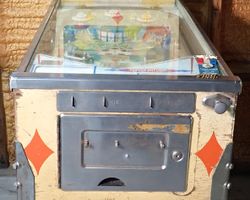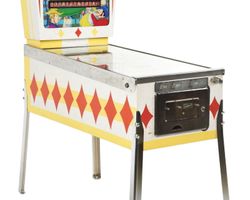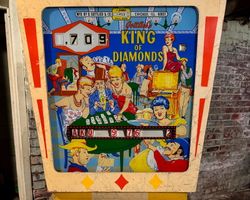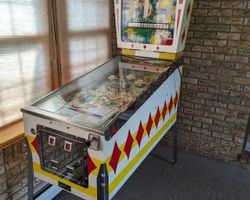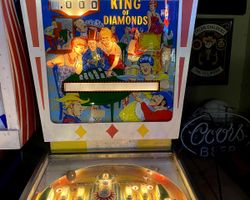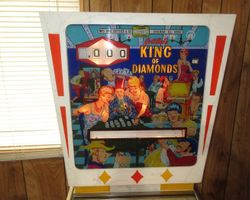King of Diamonds
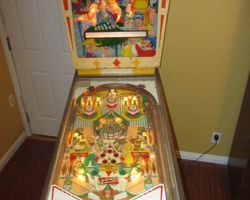
Average Prices: USD $400 to $2,000
Produced: January, 1967
Production Run: 3,200 units
Machine Type: Electro-mechanical
Players: 1
Design by: Ed Krynski
Art by: Art Stenholm
D. Gottlieb & Co. released "King of Diamonds" in January 1967, positioning it as a standout electro-mechanical (EM) pinball machine in an era defined by mechanical ingenuity and evolving playfield concepts. The machine's thematic core revolved around classic playing cards and a casino aesthetic, a popular subject that resonated with the recreational atmosphere of the time. This theme, while familiar, was executed with a distinct charm and focus. The creative force behind "King of Diamonds" was primarily Ed Krynski, credited not only with the game’s design and concept but also its animation and mechanical intricacies. Krynski’s approach often emphasized clear objectives and engaging shot-making, a philosophy evident throughout this machine. Art Stenholm contributed the distinctive artwork, imbuing the playfield and backglass with a visual style that complemented the gambling motif.
The production run for "King of Diamonds" totaled 3,200 units, a respectable number for a single-player EM game of its period. This machine is notable for being one of the last from Gottlieb to utilize a silkscreened '1' for the thousands digit in the score display, before the transition to dedicated score reels for higher scoring capabilities. Its popularity spurred the creation of an add-a-ball version, "Diamond Jack," released the same year, and an export version for Italy, "Solitaire." Additionally, the game saw production in Spain as Petaco's "Rey de Diamantes," underscoring its broad appeal. Slight variations exist between sample games and production models, such as differences in insert colors and the placement of certain playfield posts, details that offer glimpses into the iterative design process at the factory.
Signature Features and Design
"King of Diamonds" distinguishes itself through several unique elements, chief among them its rotating roto-targets. Positioned centrally on the playfield, five distinct roto-targets display various playing card values. This rotating mechanism serves as the focal point of gameplay, requiring players to time their shots precisely to hit specific card values as they come into view. This dynamic target adds a layer of strategic depth and risk-reward, transforming a static objective into a constantly shifting challenge. It is not merely a visual flourish but a core interactive element that defines the machine's distinct appeal.
Complementing the playfield’s mechanical innovation is the animated backbox, a feature that enhances player engagement and visual feedback. As players successfully collect cards, corresponding card graphics appear to drop down within the backglass display. This animation provides an immediate, satisfying visual cue of progression towards game objectives, adding a captivating element to the overall experience. Beyond these primary features, the machine incorporates the familiar staples of the era, including two flippers, three pop bumpers, two slingshots, and five standup targets. The electro-mechanical chimes and knocker provide satisfying auditory feedback, contributing to the classic pinball sensory experience. These integrated features work in concert to create a cohesive and engaging gameplay environment, drawing players deeper into the casino theme.
Playfield and Mechanics
The playfield layout of "King of Diamonds" is a testament to purposeful design, centered around the dynamic roto-target assembly. The lower playfield is equipped with two flippers, positioned to allow shots up towards the various targets. Above the flippers, two slingshot mechanisms flank the main central area, providing deflections and creating unpredictable ball movement, often directing the ball back into flipper range or towards the pop bumpers. Three pop bumpers are strategically placed in the upper-mid section of the playfield, offering chaotic scoring opportunities and helping to redirect the ball into different areas.
The heart of the playfield lies with the five rotating roto-targets. These targets, arranged in an arc, present a rotating series of card values (King, Queen, Jack, Ten, Ace) that players must hit to collect. Adjacent to these are five static standup targets, providing additional scoring and card collection opportunities. The thoughtful placement of these elements creates a flow that encourages players to aim for the central roto-target, but also necessitates skillful navigation of the surrounding bumpers and slingshots. The design philosophy emphasizes precise shot-making coupled with the unpredictable nature of EM ball physics. Visually, the playfield is adorned with Art Stenholm's artwork, which captures the casino and card game theme with a classic aesthetic. Production units feature red numbered inserts, contributing to a vibrant and clear visual presentation, while the lighting scheme effectively highlights active targets and scoring elements, guiding the player's focus during gameplay.
Gameplay Dynamics
The gameplay dynamics of "King of Diamonds" revolve around the strategic collection of playing cards, primarily through hitting the rotating roto-targets and various standup targets. The objective is to complete specific card sequences, which are directly tied to the scoring system and the game's ultimate rewards. Players initiate gameplay by plunging the ball into the playfield, aiming to accurately strike the rotating roto-targets as desired card values align. Each successful hit registers a card collected and contributes to the overall score, with a maximum displayable score of 1,999 points on the mechanical reels.
The game distinguishes itself through its progression system. As players accumulate cards, they work towards lighting "Specials," which are the ultimate objective for extended play or extra balls. This creates a compelling risk-reward scenario, as hitting the right card on the spinning target often requires a precise shot under pressure. The challenge lies in adapting to the rotating nature of the central target; what might be an easy shot one moment becomes a difficult one the next as the targets revolve. While the game does not feature complex multi-ball modes or intricate rule sets common in later solid-state machines, its depth comes from the elegant simplicity of its core mechanic and the skill required to master it. Players develop strategies around controlling the ball to ensure clean shots at the roto-target, using the pop bumpers and slingshots for advantageous deflections, and skillfully nudging the machine without triggering the "game over" tilt penalty. The excitement peaks when the "Special" is lit, creating a tangible sense of accomplishment and driving the desire for "just one more game."
Reception and Legacy
"King of Diamonds" is widely regarded as a significant and highly desirable electro-mechanical pinball machine, often cited as one of the finest "wedgehead" designs produced by Gottlieb. The feedback from the pinball community has been overwhelmingly positive, with many enthusiasts praising its addictive gameplay and enduring replayability. Its most celebrated strength is undoubtedly the innovative roto-target mechanism. This feature is frequently described as unique, providing a compelling risk-reward dynamic that keeps players engaged. The animated backbox, displaying collected cards, also garners consistent appreciation for its visual appeal and how it enhances the thematic experience.
Despite its challenges, the machine is often recommended as an excellent entry point for those new to EM pinball, thanks to its clear objectives and intuitive playfield layout. Players find it challenging yet rewarding, particularly the pursuit of lighting the coveted "Special" award. Art Stenholm's classic card-themed artwork is generally well-received, contributing to the machine's overall aesthetic charm. However, a few minor criticisms have been noted. The narrow gap between the flippers, sometimes colloquially referred to as a "Grand Canyon," can lead to frustrating and rapid drains. The smaller 2.5-inch flippers, characteristic of the era, also contribute to this perceived difficulty. While the roto-target is a highlight, some owners have reported that its mechanical nature can occasionally be prone to faults, requiring maintenance to ensure smooth operation. A minority of opinions have also suggested the playfield can feel somewhat congested around the central roto-target area, or that the artwork, while classic, might not be as visually impactful as some other machines. Despite these minor points, the overall reputation of "King of Diamonds" remains exceptionally strong. Its enduring popularity is underscored by the fact that it was one of the first vintage pinball machines to see complete reproductions of its playfield and backglass, a testament to its status as a timeless classic in pinball history. Its design principles, particularly the use of a prominent, interactive central mechanism, continued to influence subsequent EM and even early solid-state machines by demonstrating how a single, well-executed feature could define an entire game's character.
Sponsored Links
 Ebay Listings
Ebay Listings
 Auction Results
Auction Results
| Cost | Location | Date |
|---|---|---|
| USD $750 |  Ohio, United States Ohio, United States |
12 September, 2024 |
| USD $700 |  Pennsylvania, United States Pennsylvania, United States |
18 May, 2024 |
| USD $800 |  Nevada, United States Nevada, United States |
13 April, 2024 |
| USD $700 |  Pennsylvania, United States Pennsylvania, United States |
31 August, 2023 |
| USD $1,500 |  California, United States California, United States |
15 May, 2023 |
| USD $2,995 |  California, United States California, United States |
29 January, 2023 |
| USD $580 |  Pennsylvania, United States Pennsylvania, United States |
07 August, 2022 |
| USD $4,475 |  Minnesota, United States Minnesota, United States |
26 March, 2022 |
| USD $6,500 |  Minnesota, United States Minnesota, United States |
26 February, 2022 |
| USD $3,550 |  California, United States California, United States |
12 May, 2021 |


Private Policy · Search Website · Contact Us
As an eBay Partner, we may earn a commission from qualifying purchases made through links on this site, at no additional cost to you.
All trademarks and copyrighted materials remain property of their respective owners. All other content copyright 2007 - 2025 Pinpedia.

